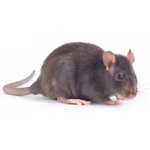
A single rat can be an intelligent and charming pet. Rats are useful animals, and certain places in the world, the rats that eat the villagers waste are used as a protein supplement to the diet.
But mostly we regard the rat as the ultimate pest, with their appetite for our food, their ability to spread diseases and their impressive adaptability and high reproductive potential.
Two rat species can be found in Northern Europe. The black rat, or the plague rat (Rattus rattus) came to Europe in the early Middle Ages, where it lived in best well-being, spreading diseases. It was the black rat fleas that transmitted the plague to humans, and was the cause of the epidemic “Black Death” that wiped out large parts of Europe’s population in the 1600s.
Today the black rat is a rare guest, it is sometimes introduced with shiploads and can be found in warehouses in ports. It does not thrive in European nature.
The black rat was in 1700 supplanted by the brown rat (Rattus norvegicus). This rat originated from East Asia but quickly spread with ships and on foot (hiking rat). Why Linné named it after his dear neighbours and called it the Norwegian rat is not known. The brown rat is larger, more aggressive and adaptable than its black relative.
Selma Lagerlöf describes in “Niels Holgersson’s Adventurous Journey” the war between the two rat species. In this tale we feel sympathi for the black rats and when the brown rats threaten to take their last refuge in Scania, Sweden, Niels Holgersson helps the black rats by luring the attacking brown rats away with a small flute. But the brown rats create problems in our part of the world today.
An adult rat is about 45 cm long and weighs about 300 g. It is normally dark brown with a lighter underside. Indoors, it breeds throughout the year. It can breed up to 5 litters, and as there can be from 4 to 12 pups in each litter, and considering that the pups reach maturity in just 3 months, it is obvious that it can quickly turn into a huge rat population.
Rats are practically omnivorous, they prefer cereal but they will just as well eat meat and can act as predators and even take chickens from chicken coops.
The rats are particularly often found in stables, warehouses and homes. In cities there will be a constant population of brown rats in the sewer systems and invasions are often caused by “sewer rats” that come up through a breach.
The brown rat is doing well in nature, in hedgerows, by streams and especially in places where waste is thrown out.
The rats are shy animals, and are primarily active when it is dark. They dare not go out in the open, but move along walls. They are, in contrast to mice distrustful of new things and do not immediately go into trap. They are also cautious about new foods, they taste carefully, and if it makes them sick they will never touch it again. This caution makes it difficult to accept the poison we serve them. The rats are able to relatively quickly develop resistance to the toxins we use.
The rats eat the equivalent of 1/10 of their body weight per day, they pollute foods, and they can even destroy buildings and installations with their gnawing. They have strong teeth and can gnaw everything softer than iron.
And not least they are dangerous disease carriers. Through their urine and droppings, they can spread the deadly, but quite rare Weil’s disease, and there is little doubt that they are responsible for a large part of the food poisoning caused by salmonella bacteria.
Therefore, it is obvious that rat control is very important. Nothing is left to the individual citizens. In most countries, the authorities are obliged to exterminate rats. .
Extermination of rats with chemical agents may only be performed by authorized persons.
The rats are difficult to to keep down in numbers, but the problems today are nothing compared to the past. Jeppe Aakjær is just one of many people describing how the rats ravaged his childhood home in the 1880s. The children lay and heard the rats make noises, often with a stick next to them to chase them away when they came trotting across the quilt. The children were even often bit in their noses.




